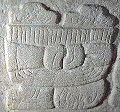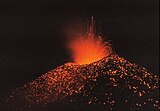The Central America Portal

Central America is a subregion of the Americas. Its political boundaries are defined as bordering Mexico to the north, Colombia to the south, the Caribbean Sea to the east, and the Pacific Ocean to the west. Central America is usually defined as consisting of seven countries: Belize, Costa Rica, El Salvador, Guatemala, Honduras, Nicaragua, and Panama. Within Central America is the Mesoamerican biodiversity hotspot, which extends from northern Guatemala to central Panama. Due to the presence of several active geologic faults and the Central America Volcanic Arc, there is a high amount of seismic activity in the region, such as volcanic eruptions and earthquakes, which has resulted in death, injury, and property damage.
In the pre-Columbian era, Central America was inhabited by the Indigenous peoples of Mesoamerica to the north and west and the Isthmo-Colombian peoples to the south and east. Following the Spanish expedition of Christopher Columbus' voyages to the Americas, Spain began to colonize the Americas. From 1609 to 1821, the majority of Central American territories (except for what would become Belize and Panama, and including the modern Mexican state of Chiapas) were governed by the viceroyalty of New Spain from Mexico City as the Captaincy General of Guatemala. On 24 August 1821, Spanish Viceroy Juan de O'Donojú signed the Treaty of Córdoba, which established New Spain's independence from Spain. On 15 September 1821, the Act of Independence of Central America was enacted to announce Central America's separation from the Spanish Empire and provide for the establishment of a new Central American state. Some of New Spain's provinces in the Central American region (i.e. what would become Guatemala, Honduras, El Salvador, Nicaragua and Costa Rica) were annexed to the First Mexican Empire; however in 1823 they seceded from Mexico to form the Federal Republic of Central America until 1838. (Full article...)
Selected article
Maya stelae (singular stela) are monuments that were fashioned by the Maya civilization of ancient Mesoamerica. They consist of tall, sculpted stone shafts and are often associated with low circular stones referred to as altars, although their actual function is uncertain. Many stelae were sculpted in low relief, although plain monuments are found throughout the Maya region. The sculpting of these monuments spread throughout the Maya area during the Classic Period (250–900 AD), and these pairings of sculpted stelae and circular altars are considered a hallmark of Classic Maya civilization. The earliest dated stela to have been found in situ in the Maya lowlands was recovered from the great city of Tikal in Guatemala. During the Classic Period almost every Maya kingdom in the southern lowlands raised stelae in its ceremonial centre.
Stelae became closely associated with the concept of divine kingship and declined at the same time as this institution. The production of stelae by the Maya had its origin around 400 BC and continued through to the end of the Classic Period, around 900, although some monuments were reused in the Postclassic (c. 900–1521). The major city of Calakmul in Mexico raised the greatest number of stelae known from any Maya city, at least 166, although they are very poorly preserved. (Full article...)Did you know...
- ... that to animate conquistadors in Jungle Cruise, frogs were recorded in a Costa Rican forest?
- ... that Nicaraguan cartoonist Pedro X. Molina has had to flee his home country twice in his lifetime?
- ... that the Central American government voted for annexation to the First Mexican Empire after a request from Regent Agustín de Iturbide?
- ... that José de la Cruz Mena, who contracted leprosy at the age of 21 and was blind at 26, was described as "the pre-eminent Nicaraguan composer of his time"?
- ... that peasant leader Medardo Mairena was the sixth aspiring presidential candidate in the 2021 Nicaraguan general election to be arrested?
- ... that Panama cross-banded tree frog males synchronize their mating calls to confuse predators that locate them by sound?
- ... that Alfredo Frohlich formed an award-winning collection of Panamanian postal history that included items from as early as 1777?
- ... that the Bitcoin Law would make El Salvador the first country to recognize bitcoin as legal tender?
Related portals
Get involved
For editor resources and to collaborate with other editors on improving Wikipedia's Central America-related articles, see WikiProject Central America.
Need help?
Do you have a question about Central America that you can't find the answer to?
Consider asking it at the Wikipedia reference desk.
General images
In the news
- 22 February 2024 –
- A court in Panama orders the arrest of former president Ricardo Martinelli, who is under protection of the Nicaraguan embassy in Panama City. (ABC News)
- 7 February 2024 –
- Nicaragua grants political asylum to former Panamanian president Ricardo Martinelli after he requests protection at the Nicaraguan embassy in Panama City, Panama. (Reuters)
- 4 February 2024 – 2024 Salvadoran general election
- Salvadorans vote to elect the president, vice president, and Legislative Assembly. With over 80% of the popular vote, Nayib Bukele wins re-election in a first-round landslide. (BBC News) (Reuters)
- 2 February 2024 – 2023 Guatemalan general election
- The European Council applies sanctions to Attorney General of Guatemala María Consuelo Porras and three of her collaborators, as well as to a judge, for undermining democracy, the rule of law, and the transfer of power. (Prensa Libre)
- 17 January 2024 –
- Former Guatemalan President Alejandro Giammattei is barred from entering the U.S. after the State Department accuses him of "significant corruption". (Reuters)
- 14 January 2024 – Inauguration of Bernardo Arévalo
- In Guatemala, the Constitutional Court aligns itself with the outgoing ruling party and denies legal recourse to Semilla, affirming that Semilla's elected members of Congress must assume office as "independents", thereby disqualifying them from running for the presidency of the Congress. The legislature of the outgoing Congress subsequently announces a delay in the investiture of the incoming legislature, as well as in the presidential investiture of Bernardo Arévalo. (Prensa Libre)
Subcategories
Topics
Associated Wikimedia
The following Wikimedia Foundation sister projects provide more on this subject:
-
Commons
Free media repository -
Wikibooks
Free textbooks and manuals -
Wikidata
Free knowledge base -
Wikinews
Free-content news -
Wikiquote
Collection of quotations -
Wikisource
Free-content library -
Wikiversity
Free learning tools -
Wiktionary
Dictionary and thesaurus
















![Image 17Mesoamerica and Central America in the 16th century before Spanish arrival [according to whom?] (from Mesoamerica)](https://upload.wikimedia.org/wikipedia/commons/thumb/0/06/Mesoam%C3%A9rica_y_Centroamerica_prehispanica_siglo_XVI.svg/120px-Mesoam%C3%A9rica_y_Centroamerica_prehispanica_siglo_XVI.svg.png)

























![Image 44Mesoamerica and its cultural areas[according to whom?] (from Mesoamerica)](https://upload.wikimedia.org/wikipedia/commons/thumb/7/79/Mesoamerica_english.PNG/120px-Mesoamerica_english.PNG)






















